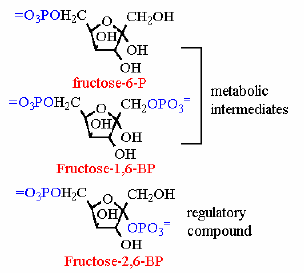| Reaction | Activity Name | Abbrev. | |
| The active site that catalyzes the reaction | Fructose-6-P + ATP  Fructose-2,6-Bisphophate + ADP Fructose-2,6-Bisphophate + ADP |
phosphofructokinase-2 (places PO4 on C2 of fructose) |
PFK-2 |
| The active site that catalyzes the reaction | Fructose-2,6-bisphosphate  Fructose-6-P + PO4= Fructose-6-P + PO4= |
Fructose-2,6-bisphosphatase | F26BPase |
| What to call the entire peptide then??? | theroretically catalyzes both reactions (we will modify this in a minute) | phosphofructokinase-2 | PFK-2 / F26BPase or just one of these for convenience depending on activity |
In general ONLY one of these activities is "active" at a time. This is a good thing since this single peptide
could catalyze that "futile cycle" all by itself. The activities are modified by covalent modification vwith a phosphate
group. More on how this gets there in the next two pages. Suffice it to say that It is placed on by an enzyme called
"cyclic AMP dependent protein kinase" and removed by another enzyme (differnt polypeptide this time) called protein
phosphatase. In the picture below, The yellow spheres represent the single polypeptide with the two activities PFK-2
and F26BPase; the * indicates the covalently modified peptide.

Recall, please that fructose-2,6-bisphophate is an activator of glycolysis (by way of stabilizing the GOOD form of the metabolic enzyme phosphofructokinase-1 ) and an inhibitor of gluconeogenesis (by way of stabilizing the POOR form of fructose-1,6-bisphosphatase).
